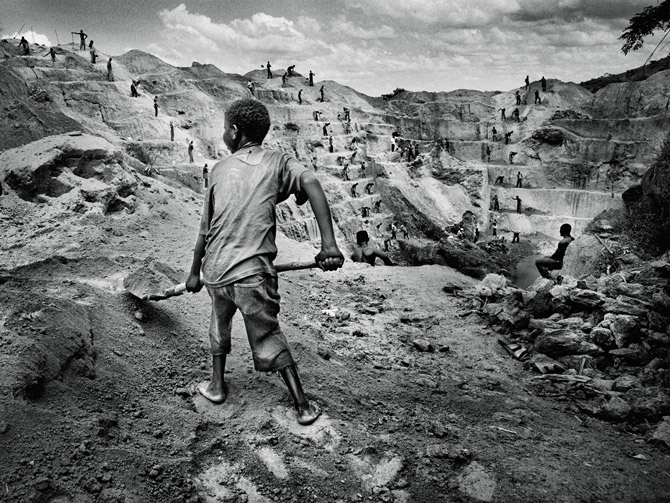
"Colonialism is no stranger to the Congolese; the lasting effects still haunt them today. Years of corrupt leadership left the country weak and vulnerable. Foreign troops and rebel groups swarmed the eastern region after the Rwandan genocide, seizing mines along the way: “It was like giving an ATM card to a drugged-out kid with a gun. The rebels funded their brutality with diamonds, gold, tin, and tantalum, a hard, gray, corrosion-resistant element used to make electronics."
The latest issue of National Geographic magazine, the 125th Anniversary Collector’s Edition "Photography Issue," explores the role conflict minerals play in the violence in eastern Congo. “The Price of Precious,” follows award-winning photojournalist Marcus Bleasdale’s and New York Times journalist Jeffrey Gettleman to Bavi, a rebel-controlled gold mine, and Nyabibwe, a conflict-free tin mine, both on the eastern edge of the Democratic Republic of the Congo.
What makes this article most fascinating is the balanced approach in talking both about the problems and the solutions. The Bavi mine is controlled by warlord and M23 ally Cobra Matata, while Nyabibwe is government-held and has been validated by a team of NGOs, the U.N., and the Congolese government as being conflict-free (though an incident of theft by the military has been reported and must be dealt with). By visiting both areas, Bleasdale and Gettleman show the progress can be made – 55 mines have been validated by the multi-stakeholder teams as being “green” or conflict-free for the first time ever. Additionally, approximately 10 percent of mines in eastern Congo have traceability systems in place, and miners’ wages have more than doubled at the pilot "closed pipe" mines like Nyabibwe. Tech giant Philips is piloting the Nyabibwe project, alongside the Dutch government and 13 other companies, called the Conflict-Free Tin Initiative.
What this shows is that companies and governments can help make progress on building up a conflict-free, responsible minerals trade that can enable peace. For example, the Banro mines in South Kivu were conflict mines just a few years ago, but rebel groups no longer operate in those areas, and roads have also been built in those areas.
What is needed now is more work by tech and jewelry companies in building up the conflict-free trade. Jewelry and other companies should join the Public-Private Alliance on Responsible Minerals Trade and pilot closed-end pipeline projects like the CFTI in Congo for gold and other minerals to increase community benefits to Congolese people.
The article goes on to highlight the impact section 1502 of the Dodd-Frank Act has had on minerals trade in eastern Congo, noting the human rights groups and lawmakers who continually asked the question: "What about minerals?" The Congolese government languished after the passage of 1502 to come up with proper traceability and certification systems, and thus supplier companies to world markets were forced to began to inspect mines and the fear of a boycott was vastly diminished. The bill does not ban companies from using conflict minerals in Congo, but rather requires them to be honest about their supply chains and encourages a greater awareness of their connection to the crisis in Congo.
As Gettleman points out, before legislation was in place, some electronics companies were already making proactive efforts to track the minerals in their products. He references the Enough Project’s conflict minerals company rankings, as well as Intel’s commitment to producing a conflict-free microprocessor in spite of the associated business costs, quoting the reasoning of Intel’s Chuck Mulloy: "We don’t want to support people who are raping, pillaging, and killing. It’s as simple as that." Intel has been the number one company in making progress on conflict minerals – committing to making a fully conflict-free computer chip, helping lead the Conflict-Free Smelter Program that audits smelters, participating in building the Solutions for Hope tantalum project in Congo, the Conflict-Free Tin Initiative, and the Public-Private Alliance for Responsible Minerals Trade, and being on the ICGLR regional minerals certification Audit Committee. Motorola Solutions and HP have also been leaders.
Eliminating conflict minerals will not solve all of the problems in Congo. However, this is a piece of the puzzle that American consumers have the ability to directly impact. Newly appointed Special Envoy for Africa's Great Lakes Region, Russ Feingold, and U.N. Special Envoy Mary Robinson will play a major role in influencing attempts for sustainable peace in the region, but there must also be sustained pressure from activists in order for lasting change to take hold. The “price of precious” may be high, but with continued efforts to raise awareness about the situation in Congo through activist pressure, the diaspora, and on-the-ground community engagement, efforts can result in hope—something we all can invest in.
Follow Marcus Bleasdale on Instagram for more photos from the story.
Check out the PBS Special on the feature article.
Photo: A child is put to work at a militia-run mine in Watsa (National Geographic/Marcus Bleasdale).

